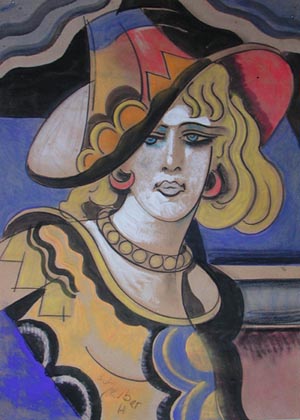Hugó Scheiber
1873-1950
Hugó Scheiber was born in Budapest in 1873. At the age of eight,
he moved with his family from Budapest to Vienna.
In 1898, to help support his family after they had returned to Budapest.
He started working during the day, attending painting classes at the
Commercial Art School in the evening. In 1900, he completed his studies.
Scheiber showed an early interest in German Expressionism and Futurism.
In 1915 he met Marinetti, who invited him to join the Futurist movement.
Because Scheiber’s paintings conflicted with academic style of
the Hungarian art establishment, his work was virtually ignored in his
own country. In 1919, he and his friend Béla Kádár
held an exhibition organized by Hévesy in Vienna, which was a
great success, so much so that the Budapest Art Museum purchased two
of his drawings.
In 1920, Scheiber returned to Vienna. A turning point in his career
came in 1921 when Herwarth Walden, founder of Germany’s leading
avant-garde periodical, “Der Sturm”, and of the Der Sturm
Gallery in Berlin, became interested in Scheiber’s work. His paintings
soon appeared regularly in Walden’s magazine. Exhibitions of his
work followed in London, Rome, La Paz, and New York.
Another turning point came in 1926, with the New York exhibition of
the Société Anonyme, organized by Katherine Dreier. Important
avant-garde artists from more than twenty-three countries were represented.
Scheiber was invited by Marinette to participate in the great meeting
of the Futrists held in Rome in 1933, where he was received with great
enthusiasm.
Scheiber’s focus on cafe life is exemplified in a number of works
illustrated in Schelgl’s “Hugo Scheiber, Leben und Werk”.
His humorous and lively drawings and paintings of dancers, acrobats,
singers, and musicians are among his classic works and always elicit
a positive response.
Scheiber’s work has been shown in many important exhibitions since
1945, including: “The Nell Walden Collection” at the Kunsthaus,
Zurich (1945), Kunsthaus Aarau (1957), and Kunstmuseum, Bern (1967);
“Collection of the Société Anonyme,” Yale
University Art Gallery, New Haven (1950); “Paris-Berlin 1900-1930,”
Centre Georges Pompidou, Paris (1978); “l’Art en Hongrie,
1905-1930,” Musée d’Art et l’Industrie, St.
Etienne (1980), and Musée d’Art Moderne de la Ville de
Paris (1981). Scheiber’s work was represented in the exhibition,
“Futurismo & Futurismi,” organized by Pontus Hulten
at the Palazzo Grassi in Venice in 1986.
|

